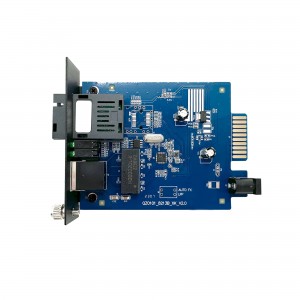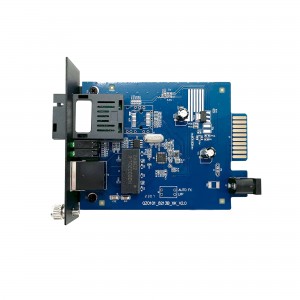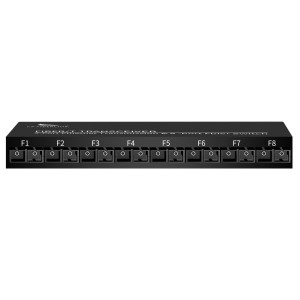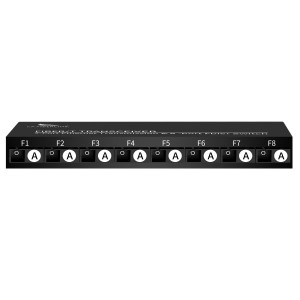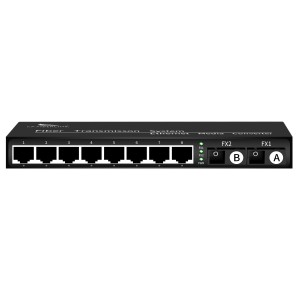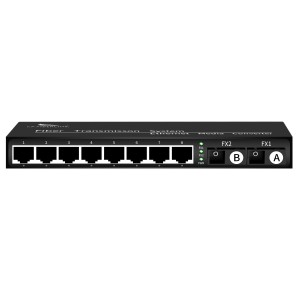5-port 10/100/1000M Media Converter(SFP)
5-port 10/100/1000M Media Converter(SFP)
Product Features:
Huizhou Changfei Optoelectronics Technology Co., Ltd. launched the optical 4 electrical SFP interface gigabit optical module and the 5-port gigabit optical module. As a leading overall transmission solution provider, we are committed to providing advanced products and first-class services to global customers.
With our many years of research and development experience, as well as numerous photoelectric product research patents, we have established a good reputation in the industry. At present, we have successfully cooperated with more than 360 distributors and agents in more than 100 countries, and won unanimous praise.
Our Fiber 4 Electrical SFP Interface Gigabit Transceivers combine cutting-edge technology with superior functionality. It is equipped with 1 optical fiber and 4 electrical SFP interfaces for seamless communication and transmission. The transceiver has a wide voltage supply range of DC5-12V, which provides flexibility and convenience for various applications. In addition, its ports support 4KV lightning protection to ensure the safety and longevity of your network equipment.
Our transceivers operate over a wide temperature range, ensuring reliable performance even in challenging environments. It also supports 10KB jumbo frames for efficient data transfer and reduced latency. Thanks to its low power consumption, you can enjoy energy efficiency without sacrificing performance.
For enhanced usability, our transceivers feature a 4-digit dial and dynamic LED indicators. These user-friendly components provide easy navigation and visual status updates. It also supports plug-and-play functionality for easy installation and configuration.
Our transceivers are iron-cased for durability and reliability. It has an IP30 rating, ensuring strong protection against dust and moisture, making it suitable for indoor and outdoor installations. In addition, it comes with an external power supply for added convenience.
In addition to Optical 4 Electrical SFP Interface Gigabit Transceivers, we also offer 5 Port Gigabit Transceivers. The device offers five ports, each capable of providing high-speed Gigabit connections. Whether you need to expand your network or connect multiple devices, this transceiver offers exceptional performance and versatility.
In a word, Huizhou Changfei Optoelectronics Technology Co., Ltd. is proud to launch the optical 4 electrical SFP interface gigabit optical module and the 5 port gigabit optical module. With a commitment to innovation and customer satisfaction, we strive to provide exceptional products and services. With advanced transmission solutions, choose our transceivers and experience seamless connectivity that meets your needs.
What This Product Does
◇ The CF-1004W-SFP is a media converter designed to convert between 1000BASE-X fiber and 10/100/1000Base-T copper media. It easily extends the distance of an existing gigabit network via fiber optic when integrated with the SFP Module. The CF-1004W-SFP applies the IEEE802.3ab 1000Base-T & IEEE802.3z 1000Base-X standards as part of its intended use with multi-mode/single-mode SFP Module. Long-range point-to-point connections are easily built with the gigabit fiber converters, making them ideal for network connections across multiple buildings, for remote surveillance and automated factory equipment.
Other Features
◇ CF-1004W-SFP offers flexible installation on standalone desktops. The easy-to-view front panel status LEDs provide real-time status information to monitor up-to-the-minute network activity. While the maximum transmission distance of fiber optics depends on the insertion of the SFP module.
technical parameter:
| Model | CF-1004W-SFP | |
| Interface Characteristics | ||
| Fixed Port | 4* 10/ 100/ 1000Base-T RJ45 port
1* 1000Base-X uplink SFP fiber port |
|
| Ethernet Port | 10/ 100/ 1000Base-T auto-sensing, full/half duplex MDI/MDI-X self-adaption | |
| Twisted Pair
Transmission |
10BASE-T: Cat3,4,5 UTP(≤100 meter)
100BASE-T: Cat5e or later UTP(≤100 meter) 1000BASE-T : Cat5e or later UTP(≤100 meter) |
|
| Optical Port | Gigabit SFP optical fiber interface, default not include optical modules (optional single-mode / multi-mode, single fiber / dual fiber optical module. LC) | |
| Wavelength/Distance | multimode: 850nm 0~550M,1310nm 0~2KM
single mode: 1310nm 0~40KM ,1550nm 0~120KM |
|
| Chip Parameter | ||
| Network Protocol | IEEE802.3 10BASE-T, IEEE802.3i 10Base-T,
IEEE802.3u 100Base-TX, IEEE802.3u 100Base-FX, IEEE802.3x IEEE802.3ab 1000Base-T;IEEE802.3z 1000Base-X; |
|
| Forwarding Mode | Store and Forward(Full Wire Speed) | |
| Switching Capacity | 10Gbps | |
| Buffer Memory | 7.44Mpps | |
| MAC | 2K | |
| LED Indicator | Fiber | FX(green) |
| Data | 1X/2X/3X/4X(green) | |
| Power | PWR (green) | |
| Power | ||
| Working Voltage | AC:100-240V | |
| Power Consumption | Standby<1W, Full load<5W | |
| Power Supply | DC:5V/2A industrial power supply | |
| Lightning protection &Certification | ||
| Lightning protection | Lightning protection: 4KV 8/20us, Protection level: IP30 | |
| Certification | CCC;CE mark, commercial; CE/LVD EN60950;FCC Part 15 Class B; RoHS | |
| Physical Parameter | ||
| Operation TEMP | -20~+55°C;5%~90% RH Non condensing | |
| Storage TEMP | -40~+85°C;5%~95% RH Non condensing | |
| Dimension (L*W*H) | 94mm* 71mm*27mm | |
| Installation | Desktop | |
Product Size:
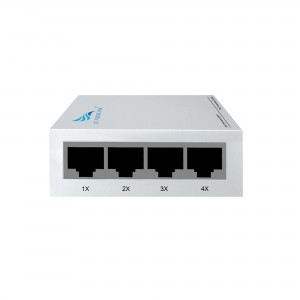
Product application diagra:

How to choose a fiber optic transceiver?
Optical fiber transceivers break the 100-meter limitation of Ethernet cables in data transmission. Relying on high-performance switching chips and large-capacity caches, while truly achieving non-blocking transmission and switching performance, they also provide balanced traffic, isolation and conflict. Error detection and other functions ensure high security and stability during data transmission. Therefore, fiber optic transceiver products will still be an indispensable part of actual network construction for a long time. So, how should we choose fiber optic transceivers?
1. Port function test
Mainly test whether each port can work normally in the duplex state of 10Mbps, 100Mbps and half-duplex state. At the same time, it should be tested whether each port can automatically select the highest transmission speed and automatically match the transmission rate of other devices. This test can be included in other tests.
2. Compatibility test
It mainly tests the connection ability between the optical fiber transceiver and other devices compatible with Ethernet and Fast Ethernet (including network card, HUB, Switch, optical network card, and optical switch). The requirement must be able to support the connection of compatible products.
3. Cable connection characteristics
Test the fiber optic transceiver’s ability to support network cables. First, test the connection ability of Category 5 network cables with lengths of 100m and 10m, and test the connection ability of long Category 5 network cables (120m) of different brands. During the test, the optical port of the transceiver is required to have a connection capability of 10Mbps and a rate of 100Mbps, and the highest must be able to connect to a full-duplex 100Mbps without transmission errors. Category 3 twisted pair cables may not be tested. Subtests can be included in other tests.
4. Transmission characteristics (transmission loss rate of data packets of different lengths, transmission speed)
It mainly tests the packet loss rate when the optical fiber transceiver optical port transmits different data packets, and the connection speed under different connection rates. For the packet loss rate, you can use the test software provided by the network card to test the packet loss rate when the packet size is 64, 512, 1518, 128 (optional) and 1000 (optional) bytes under different connection rates. , the number of packet errors, the number of packets sent and received must be more than 2,000,000. Test transmission speed can use perform3, ping and other software.
5. The compatibility of the whole machine to the transmission network protocol
It mainly tests the compatibility of fiber optic transceivers to network protocols, which can be tested in Novell, Windows and other environments. The following low-level network protocols such as TCP/IP, IPX, NETBIOS, DHCP, etc. must be tested, and the protocols that need to be broadcast must be tested. Optical transceivers are required to support these protocols (VLAN, QOS, COS, etc.).
6. Indicator status test
Test whether the status of the indicator light is consistent with the description of the panel and the user manual, and whether it is consistent with the current status of the fiber optic transceiver.








